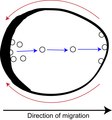Cell migration
Cell migration refers to the movement of cells from one area to another. This process is essential for a variety of biological functions, including embryogenesis, wound healing, and immune response. Cell migration plays a critical role in both normal physiological processes and pathological conditions such as cancer metastasis and inflammation.
Mechanisms of Cell Migration[edit]
Cell migration is a complex process that involves several steps and mechanisms. The primary mechanisms include:
- Chemotaxis: Movement of cells in response to a chemical stimulus. Chemokines and other signaling molecules can attract or repel cells, guiding their movement.
- Haptotaxis: Migration towards higher concentrations of adhesion molecules. Cells move along a substrate by attaching to and detaching from specific molecules.
- Electrotaxis: Also known as galvanotaxis, this refers to the movement of cells in response to an electric field.
- Mechanotaxis: Cell movement directed by mechanical cues or forces, such as stiffness of the surrounding environment.
Cell Migration Process[edit]
The process of cell migration typically involves several key steps:
1. Polarization: The cell becomes polarized, with the formation of a leading edge and a trailing edge. 2. Protrusion: The leading edge of the cell extends forward through the formation of lamellipodia (broad, sheet-like extensions) or filopodia (thin, finger-like extensions). 3. Adhesion: The cell forms temporary attachments to the substrate through integrins and other adhesion molecules. 4. Translocation: The cell body moves forward, driven by the contraction of actin filaments. 5. Detachment: The trailing edge of the cell detaches from the substrate, allowing the cell to move forward.
Regulation of Cell Migration[edit]
Cell migration is tightly regulated by a complex network of signals that control the assembly and disassembly of the cytoskeleton, the formation of cell-substrate adhesions, and the generation of forces necessary for movement. Key regulators include:
- Growth factors: Such as epidermal growth factor (EGF) and fibroblast growth factor (FGF), which can stimulate cell migration.
- Extracellular matrix (ECM) components: Including fibronectin, collagen, and laminin, which provide a scaffold for cell movement.
- Cell adhesion molecules: Such as integrins, which mediate the attachment and detachment of cells to and from the ECM.
- Cytoskeletal proteins: Including actin and microtubules, which are essential for the formation of protrusions and the generation of locomotive force.
Cell Migration in Disease[edit]
Aberrant cell migration is implicated in a variety of diseases:
- In cancer, tumor cells can migrate from the primary site to distant organs, a process known as metastasis.
- Inflammatory diseases, such as rheumatoid arthritis, involve the migration of immune cells to sites of inflammation.
- Impaired wound healing can result from dysfunctional migratory responses of cells involved in tissue repair.
Conclusion[edit]
Cell migration is a fundamental biological process that is essential for life. Understanding the mechanisms and regulation of cell migration can provide insights into a wide range of physiological processes and diseases. Ongoing research in this field continues to uncover the complex interplay of signals that govern cell movement, offering potential targets for therapeutic intervention in disease.
-
Cell migration models
-
Microtubule in cell migration
-
Adhesion-independent migration
-
Collective mechanism of cell motion
Ad. Transform your life with W8MD's Budget GLP-1 injections from $75


W8MD offers a medical weight loss program to lose weight in Philadelphia. Our physician-supervised medical weight loss provides:
- Weight loss injections in NYC (generic and brand names):
- Zepbound / Mounjaro, Wegovy / Ozempic, Saxenda
- Most insurances accepted or discounted self-pay rates. We will obtain insurance prior authorizations if needed.
- Generic GLP1 weight loss injections from $75 for the starting dose.
- Also offer prescription weight loss medications including Phentermine, Qsymia, Diethylpropion, Contrave etc.
NYC weight loss doctor appointmentsNYC weight loss doctor appointments
Start your NYC weight loss journey today at our NYC medical weight loss and Philadelphia medical weight loss clinics.
- Call 718-946-5500 to lose weight in NYC or for medical weight loss in Philadelphia 215-676-2334.
- Tags:NYC medical weight loss, Philadelphia lose weight Zepbound NYC, Budget GLP1 weight loss injections, Wegovy Philadelphia, Wegovy NYC, Philadelphia medical weight loss, Brookly weight loss and Wegovy NYC
|
WikiMD's Wellness Encyclopedia |
| Let Food Be Thy Medicine Medicine Thy Food - Hippocrates |
Medical Disclaimer: WikiMD is not a substitute for professional medical advice. The information on WikiMD is provided as an information resource only, may be incorrect, outdated or misleading, and is not to be used or relied on for any diagnostic or treatment purposes. Please consult your health care provider before making any healthcare decisions or for guidance about a specific medical condition. WikiMD expressly disclaims responsibility, and shall have no liability, for any damages, loss, injury, or liability whatsoever suffered as a result of your reliance on the information contained in this site. By visiting this site you agree to the foregoing terms and conditions, which may from time to time be changed or supplemented by WikiMD. If you do not agree to the foregoing terms and conditions, you should not enter or use this site. See full disclaimer.
Credits:Most images are courtesy of Wikimedia commons, and templates, categories Wikipedia, licensed under CC BY SA or similar.
Translate this page: - East Asian
中文,
日本,
한국어,
South Asian
हिन्दी,
தமிழ்,
తెలుగు,
Urdu,
ಕನ್ನಡ,
Southeast Asian
Indonesian,
Vietnamese,
Thai,
မြန်မာဘာသာ,
বাংলা
European
español,
Deutsch,
français,
Greek,
português do Brasil,
polski,
română,
русский,
Nederlands,
norsk,
svenska,
suomi,
Italian
Middle Eastern & African
عربى,
Turkish,
Persian,
Hebrew,
Afrikaans,
isiZulu,
Kiswahili,
Other
Bulgarian,
Hungarian,
Czech,
Swedish,
മലയാളം,
मराठी,
ਪੰਜਾਬੀ,
ગુજરાતી,
Portuguese,
Ukrainian


